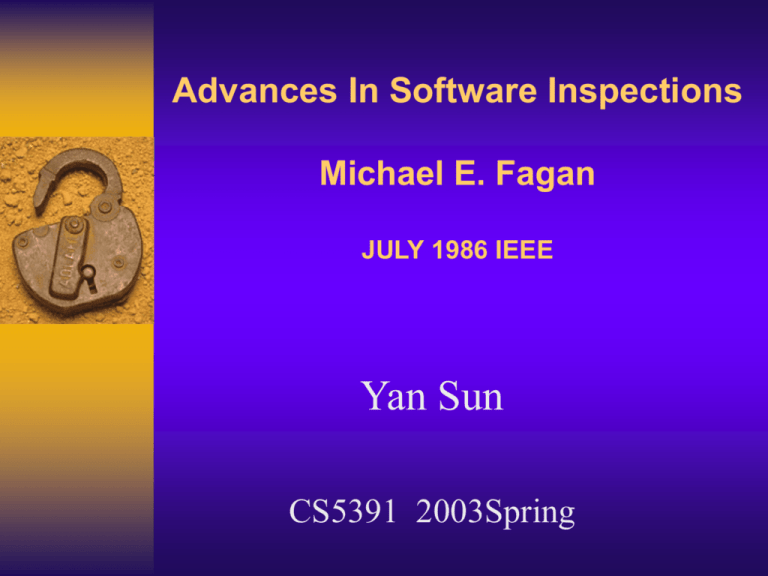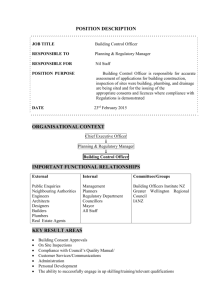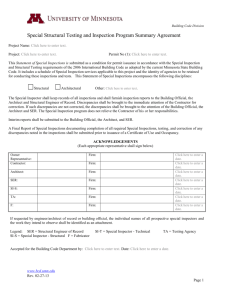Advances In Software Inspections
advertisement

Advances In Software Inspections Michael E. Fagan JULY 1986 IEEE Yan Sun CS5391 2003Spring OUTLINE Present new studies and experiences that enhance the use of the inspection process and improve its contribution to a development of defect-free software on time and at lower costs. Give examples of benefits Describe the process and methods of obtaining the enhanced results. Introduction(1) Software inspection definition A method of static testing to verify that software meets its requirements. Software inspection origin Created in 1972, in IBM Kingston. NY , for the dual purposes of improving software quality and increasing programmer productivity . Introduction(2) Benefits Software Inspection DEFECT REDUCTION DEFECT PREVENTION COST IMPROVEMENT In March 1984, L. H. Fenton. IBM Director of VM Programming Systems, made an important statement on quality improvement due to inspections. Introduction(3) Sample: Introduction(4) Experience has shown that inspections have the effect of slightly front-end loading the commitment of people resources in development, adding to requirements and design, while greatly reducing the effort required during testing and for rework of design and code. The result is an overall net reduction in development resource, and usually in schedule too. Introduction(5) Other sample showing that: the enhancements to inspections is probable that inspections will help bring further reductions in defect injection and detection rates. Inspections improve quality and reduce costs follow. SOFTWARE QUALITY PROBLEM It is the result of defects in code and documentation causing failure to satisfy user requirements. A defect is an instance in which a requirement is not satisfied. A requirement is any agreed upon commitment. It is not only the recognizable external product requirement, but can also include internal development requirements. EITGHT ATTRIBUTES DESCRIBING SOFTWARE QUALITY Intrinsic code quality, Freedom from problems in operation, Usability, Installability, Documentation for intended users Portability, Maintainability and extendability, and “fitness for use"- that implicit conventional user needs are satisfied. INSPECTIONS AND THE SOFTWARE QUALITY PROBLEM Each of these attributes of software quality were evaluated by testing and the end user. Now, some of them are being partly, and others entirely, verified against requirements by inspection. Inspection have been instrumental in improving all aspects of software . product quality ,as well as the quality of logic design and code. DEFINITION OF THE DEVELOPMENT PROCESS (1) The software development process in a series of operations so arranged that its execution will deliver the desired end product. Operations include: requirements definition, System Design, High Level Design, Low level Design, Coding, Unit Testing, component or Function Testing, System Testing, and then user support and Maintenance. DEFINITION OF THE DEVELOPMENT PROCESS (2) Essence of 4 key criteria for coding operation: 1. The source code must be at the “first clean compilation” level. That means it must be properly compiled and be free of syntax errors. 2. The code must accurately implement the low level design 3. All design changes to date are included in the code. 4. All rework resulting from the code inspection has been included and verified. SOFTWARE INSPECTION OVERVIEW Three essential requirements for the implementation of inspections 1. Definition of the DEVELOPMENT PROCESS in terms of operations and their EXIT CRITERIA 2. Proper DESCRIPTION of the INSPECTION PROCESS 3. CORRECT EXECUTION of the INSPECTION PROCESS. (correct execution of the process is vital.) THE INSPECTION PROCESS (1) It consists of six operations 1. Planning 2. Overview(the only operation that under certain 3. 4. 5. 6. conditions can be omitted with slight risk ) Preparation Inspection Rework Follow-Up THE INSPECTION PROCESS (2) To assist the inspectors in finding defects, for not all inspectors start off being good detectives, a checklist of defect types is created to help them identify defects appropriate to the exit criteria of each operation whose product is to be inspected. PEOPLE AND INSPECTIONS (1) The roles of inspection participants : 1. Author (Designer or Coder). 2. Reader (who paraphrases the design or code as if they will implement it). 3. Tester (who views the product from the testing standpoint). 4. Moderator. (a key player and requires special training to be able to conduct inspections that are optimally effective ) PEOPLE AND INSPECTIONS (2) Three separate classes of education for proper long lasting implementation of inspections. 1. Management requires a class of one day to familiarize them with inspections and their benefits to management, and their role in making them successful. 2. The Moderators need three days of education. 3. The other Participants should receive one half day of training on inspections, the benefits, and their roles. MANAGEMENT AND INSPECTIONS A definite philosophy and set of attitudes regarding inspections and their results is essential. The management education class on inspections is one of the best ways to gain the knowledge. Inspection results must never be used for personnel performance appraisal. However, the results of testing should be used for performance appraisal. INSPECTION RESULTS AND THEIR USES (1) The defects found by inspection are immediately recorded and classified by the moderator before being entered into the project data base. Here is an example: In module: XXX, Line: YYY, NAMECHECK is performed one less time than required --- LO/W/MAJ INSPECTION RESULTS AND THEIR USES (2) Inspection results can be used to identify defect 1. 2. 3. prone design and code. Many Process and Quality Control uses for inspection data including: Feedback to improve the development process by identification and correction of the root causes of systematic defects before more code is developed Feed-forward to, prepare the process ahead to handle problems or to evaluate corrective action in advance (e.g., handling defect prone code); Continuing improvement and control of inspections. VARIOUS APPLICATIONS OF INSPECTIONS Any thing that is created by a development process and that can be made visible and readable can be inspected, including: Hardware logic, software logic design, code, software test plans and test cases, user documentation, high level design, system structure design, design changes, requirements development, and microcode. Application: Employed for cleaning up defect prone code, and improving the quality of code that has already been tested. CONTRIBUTORS TO SOFTWARE INSPECTION QUALITY (1) Quality of inspection is defined as its ability to detect all instances in which the product does not meet its requirements. CONTRIBUTORS TO SOFTWARE INSPECTION QUALITY (2) The following rates should be used in planning the I2 code inspection: OVERVIEW: 500 Noncommentary Source Statements per Hour. PREPARATION: 125 Noncommentary Source Statements per Hour . INSPECTION: 90 Noncommentary Source Statements per Hour. ----------------------------------------------------Maximum Inspection Rate: 125 Noncommentary Source Statements per Hour . SUMMARY (1) Experience over the past decade has shown software inspections to be a potent defect detection method, finding 60 - 90 percent of all defects, as well as providing feedback that enables programmers to avoid injecting defects in future work. As well as providing checkpoints to facilitate process management, inspections enable measurement of the performance of many tools and techniques in individual process operations. It appears that anything that can be created and described can also be inspected. SUMMARY (2) the following key aspects must be managed to take full advantage of the many benefits that inspections offer: 1. Defect Detection 2. Defect Prevention (or avoidance) 3. Process Management



